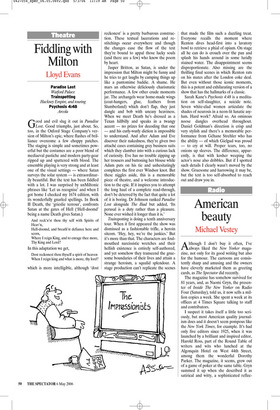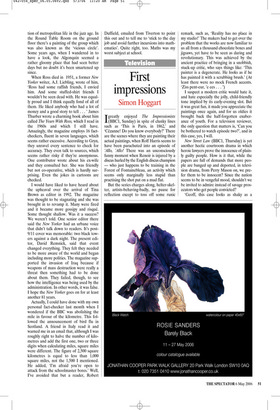American beauty
Michael Vestey
Although I don’t buy it often, I’ve always liked the New Yorker magazine, not only for its good writing but also for the humour. The cartoons are consistently sharp and amusing and the owners have cleverly marketed them as greeting cards, as The Spectator did recently.
The magazine has somehow survived for 81 years, and, as Naomi Gryn, the presenter of Inside The New Yorker on Radio Four (Saturday), told us, it now sells a million copies a week. She spent a week at its offices at 4 Times Square talking to staff and contributors.
I suspect it takes itself a little too seriously, but most American quality journalism does and it doesn’t seem pompous like the New York Times, for example. It’s had only five editors since 1925, when it was launched by a brilliant and inspired editor, Harold Ross, part of the Round Table of writers and wits who lunched at the Algonquin Hotel on West 44th Street, among them the wonderful Dorothy Parker. The magazine, it seems, grew out of a game of poker at the same table. Gryn summed it up when she described it as satirical and witty, a sophisticated reflec tion of metropolitan life in the jazz age. In the Round Table Room on the ground floor there’s a painting of the group which was also known as the ‘vicious circle’. Some years ago, when I wandered in to have a look, the Algonquin seemed a rather gloomy place that had seen better days but no doubt it’s been smartened up since.
When Ross died in 1951, a former New Yorker writer, A.J. Liebling, wrote of him, ‘Ross had some raffish friends, I envied him. And some stuffed-shirt friends I wouldn’t be seen dead with. He was equally proud and I think equally fond of all of them. He liked anybody who had a lot of money and a good story to tell ... ’ James Thurber wrote a charming book about him called The Years With Ross, which I read in the 1960s and which I still have. Amazingly, the magazine employs 16 factcheckers, fluent in seven languages, which seems rather excessive. According to Gryn, they unravel every sentence to check for accuracy. They even talk to sources, which seems rather risky if they’re anonymous. One contributor wrote about his ex-wife and they consulted her. She was friendly but not co-operative, which is hardly surprising. Even the jokes in cartoons are checked.
I would have liked to have heard about the upheaval over the arrival of Tina Brown as editor in 1992. The magazine was thought to be stagnating and she was brought in to revamp it. Many were fired and it became more gossipy and risqué. Some thought shallow. Was it a success? We weren’t told. One senior editor there said the New Yorker had an urbane voice that didn’t talk down to readers. It’s post9/11 cover was memorable: two black towers against a dark night. The present editor, David Remnick, said that event changed everything. They felt they needed to be more aware of the world and began including more politics. The magazine supported the invasion of Iraq because if weapons of mass destruction were really a threat then something had to be done about them. They failed, though, to see how the intelligence was being used by the administration. In other words, it was false. I hope the New Yorker goes on for at least another 81 years.
Actually, I could have done with my own personal fact-checker last month when I wondered if the BBC was abolishing the mile in favour of the kilometre. This followed the announcement of bird flu in Scotland. A friend in Italy read it and warned me in an email that, although I was roughly right to halve the number of kilometres and add the first one, two or three digits when calculating miles, square miles were different. The figure of 2,500 square kilometres is equal to less than 1,000 square miles, not the 1,500 I mentioned. He added, ‘I’m afraid you’re open to attack from the schoolmaster bores.’ Well, I’ve avoided that but a reader, Robert Duffield, emailed from Tiverton to point this out and to tell me to ‘stick to the day job and avoid further incursions into mathematics’. Quite right, too. Maths was my worst subject at school.















































 Previous page
Previous page